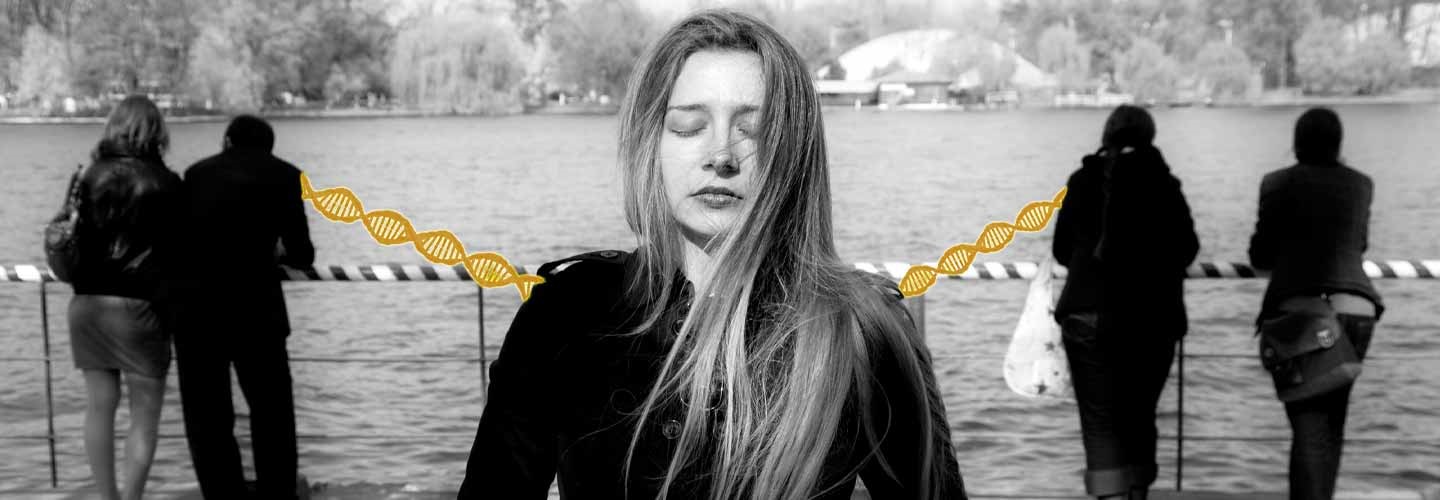The DNA of Emotional Health – Part 3 Biohacking OXTR: the “I Feel Comforted” Gene
- Home
- Blog

Reader, what brings you emotional comfort? A feeling of inner peace? Perhaps it’s connecting with nature by taking long walks in the forest. Or, perhaps it’s communing with your friends over great food and deep conversation. Physical intimacy can make both our bodies and our brains feel good. Bonding, loving, and emotionally connecting are all universal answers to this question. Now, let me rephrase that same question: What makes feeling comforted… well, comforting? What causes that warm “feel-good” sensation to flood our minds and bodies, causing us to relax, ease up, and feel so content with the world? The answer lies in a little chemical called Oxytocin. We’ve not yet covered this magical, powerful hormone in depth on the blog, and as we move into the early days of summer, when the evenings get longer and sun slows our pace, it seems like the perfect time to talk about how feel-good Oxytocin influences us on a day-to-day basis. Our genetic code plays an important role in regulating Oxytocin—and the more we know about how our body’s genes that code for the production of oxytocin receptors, known as OXTR, the more we can biohack our lifestyles to make our bad times feel better.
OXTR: How One Gene with Two Variants Can Affect Your Psychological Wellbeing
To return to my initial question: What does life look like when you feel comforted? A feeling of well-being can come from taking an optimistic view on life, having healthy levels of self-esteem, and maintaining an attitude that we can overcome whatever comes our way. And how might the magical Oxytocin relate to these feelings? This fascinating “peptide hormone” is produced in the hypothalamus in our brain, and becomes both a neurotransmitter inside the brain, and a hormone released into the blood stream through the pituitary gland, where it then circulates throughout our body. In the brain, it is known as the “social hormone” as it is intimately involved in human bonding and is increasingly recognized as an important regulator of human social behaviors, including social decision making, evaluating and responding to social stimuli, mediating social interactions, and forming social memories. It also triggers the bond between mother and infant and is involved in the development of trust. In the body, it plays a crucial role in the childbirth process, in breastfeeding, and also helps with male reproduction. Amazing effects from one tiny molecule! And yet, its effects ultimately depend upon the receptors in the body that it binds to, and the OXTR gene determines the attributes of those Oxytocin receptors—thus the importance of learning how we can biohack this gene.
Do You Have the OXTR Gene “G/G” or “A” Variant?
Now here is where it gets more complicated, because the effects of Oxytocin depend in part upon our personal genetic makeup, and which type of OXTR gene we have inherited from our parents determines our response to stress and other emotional attributes. For example, if we have a G/G variant, we have increased sensitivity to Oxytocin, which makes us more empathetic, and with good social support we have increased stress resilience and coping abilities, and increased heart rate variability (a measure of lower stress response and lower rates of cardiovascular disease). But with this variant we also have an “orchid gene” (increased activation of the amygdala under stress) which, without that social support, confers decreased resilience to childhood trauma with higher rates of developing depression in response to the trauma. With this variant there is also a greater sensitivity to social stress, again in the absence of good social support. If you have the G variant, social support is key to good emotional health.
With the G/A or A/A variant one is more of a “dandelion” with less sensitivity to Oxytocin, lower activation of the amygdala under stress, less empathy with corresponding deficits in social behavior, and less optimism. It also confers increased resilience to childhood trauma and social stress. However, if you have the A variant and suffer from depression, anxiety, or PTSD, intranasal oxytocin may help improve mood and reduce your anxiety and fear response!
With Debbie’s story, we will illustrate the genetics of OXTR in a real-life example. We explore how her mental illness may have precluded her from getting the benefits of her own natural Oxytocin resources, and find out how biohacking her genes made her feel 100% better
Debbie’s Story: Years of Mental Illness Cured in part through Two Simple Cheek Swabs
I greeted Debbie* in the waiting room for the first time with a warm smile, which she returned with an ear-to-ear grin. This was surprising, as she told our staff members while booking her appointment that she was deeply depressed and had given up hope of ever recovering. Once back in my office her smile quickly faded, and she began crying. She had seen several psychiatrists over the past few years, had been placed on a number of SSRI and SNRI medications, alone and with medications to augment them, and yet she did not feel any better—in fact she felt worse than ever before.
“Debbie, having tried for years to manage your depression, only to have nothing work for you, may feel so isolating and hopeless,” I told her with empathy and compassion, and looking her in the eye. “But I want you to know—I’m so glad you’re here in my office today, because I believe we can try something completely different, which may have you feeling better in a matter of months.”
One of the most important gifts a doctor can give to a patient is to both provide hope and set realistic expectations. Nothing is worse for a patient than to be let down or led along by false hope. But when I told Debbie I believed we could make her whole, it was because I felt confident that we would. I’ve seen such an overwhelmingly positive response in my practice to our “leave no stone unturned” personalized precision psychiatry model, and I wanted Debbie to feel that hope was still within her grasp.
Debbie was all in on my suggestion. While she had given up hope just days before of ever finding a solution, a fire lit within her once again when I told her about next steps. I could tell she wanted to heal, and I was going to help her do just that. Because she was willing to try anything to feel better, including prescription medication (which had failed her so far) and supplements, we swabbed her cheeks twice, once for Genecept and once for Mindful DNA genetic test assays. In addition, while she had been treated repeatedly for an “agitated depression,” I believed this diagnosis to be incorrect. She simultaneously exhibited symptoms of both depression and hypomania, which are more aligned with a diagnosis of Bipolar Disorder with Mixed Features (in her case a “mixed state depression”). We kept this new diagnosis in mind as we moved step by step through her treatment process.
Her Genecept Assay revealed an “orchid gene” SLC6A4 S/S, and variants in MTHFR and CACNA1C which all served to reduce her emotional resilience and predispose her to higher rates of prolonged stress response, depression, and anxiety. As a result of her revised diagnosis and personal genome analysis, over the next month we weaned her off her SSRI (which had made her mixed state symptoms worse) and initiated a combination of Rexulti, Bupropion, Deplin, and high dose Omega 3. Two months later, she was about 80% better. Our biohacking process was working!
We then began to focus on her Mindful DNA results, with a particular emphasis on the “Stress and Emotional Well Being” genes. As she suffered from migraine headaches, and had the LRP1 variant, we added magnesium and CoQ10 supplements and in a few months the frequency and intensity of the headaches had begun to abate; and to address her CRHR1 variant (bringing higher activation levels and longer durations of her “fight, flight, or freeze” responses) we added n-acetylcysteine.
90% Better is Not Enough: How Biohacking the OXTR Gene Would Help Debbie Reach That Last 10%
Four months into our treatment, Debbie was about 90% better, yet something was still missing. She felt a kind of emptiness, and we began to talk in therapy about her loneliness. Her solitude was taking a toll, and I explored with her the history of her interpersonal relations. While she had never married, over many years she’d benefitted from close, loving relationships with girlfriends, who had become confidants, and with whom she’d been able to discuss anything and everything. Given her shame over her depression she’d lost touch with them over the years.
And that led us to biohacking her OXTR G/G variant, which pointed toward her being someone who benefits from increased social support in the face of adverse life events. Sadly, perhaps the very thing she needed the most during the years she was depressed—the love and support of her friends—she denied herself out of shame and “not wanting to burden them.”
I gently encouraged her to pick up the phone and call one or two of these old friends, and we rehearsed what she could say to break the ice with them. I am hopeful she will reconnect in a way that brings about a full recovery because, at the end of the day, no medications or supplements can substitute for the love of another human being.
.png?width=144&height=144&name=Untitled%20design%20(34).png)



